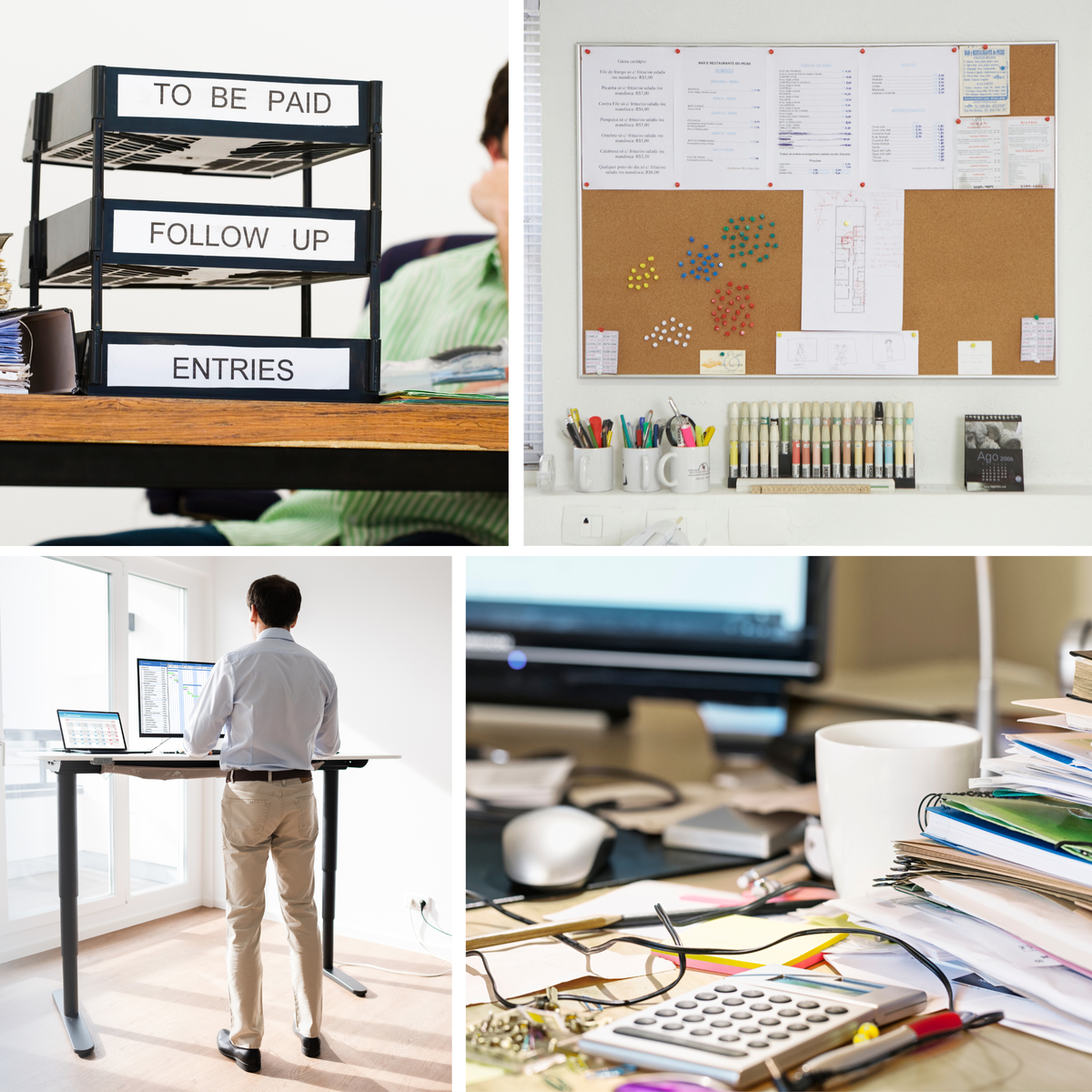Key Takeaways:
- An organized desk space is crucial for enhancing productivity and focus.
- Ergonomic furniture and smart use of office supplies can significantly boost productivity.
- Regular maintenance of your desk organization can lead to a more efficient and enjoyable work experience.
Managing your office desk for productivity isn't just about having a clean space; it's about creating an environment that fosters efficiency, clarity, and well-being. With the right approach, your desk can transform into a powerhouse of productivity. This article will guide you through the steps to achieve a productive desk setup, ensuring that every element of your office space contributes to your most productive self.
The Foundation: Ergonomic Office Chair and Desk
An ergonomic chair is the cornerstone of any productive workspace. A good office chair supports your posture, reduces the risk of neck pain, and increases comfort during prolonged periods of work. Similarly, the desk should provide enough room to rest flat your arms and hold your computer monitors at eye level.

Optimize Your Desk Layout
The desk layout is pivotal in how to manage office desk for productivity. Your computer monitors should be at an arm's length, with the top of the screen at or slightly below eye level. This setup helps improve focus and reduce eye strain. Ensure that there's a designated space for your keyboard tray and mouse, allowing your arms to rest comfortably.
Declutter for a Streamlined Workspace
A cluttered desk can lead to a cluttered mind. Keep only what is essential on your desk. Use filing cabinets and additional storage space to store supplies that are not in immediate use. This approach not only creates more room but also minimizes visual clutter, helping you to stay focused.
Organize Your Desk with Smart Office Supplies
Desk organization can be significantly improved with the right office supplies. Use file folders for important documents, sticky notes for urgent tasks, and a bulletin board for to-do lists. This system helps keep your work desk organized and ensures that important items are within reach.

Personalize with A Few Meaningful Objects
While it's important to avoid a cluttered desk, a few meaningful objects can make your desk feel more personal and boost morale. This could be a photo, a small plant, or a memo pad with your favorite quotes. However, ensure these items don't become a distraction or take up valuable desk space.
Embrace Natural Light and Positioning
Position your desk to take advantage of natural light, which can help increase productivity and improve your well-being. If natural light isn't available, invest in a good desk lamp that provides ample lighting without causing glare on your computer screens.
Utilize Wall Space for Additional Organization
Don't overlook the wall space above your desk. A wall shelf or bulletin board can be used to keep important information visible and off your desk. This helps maintain a clean desk while still having easy access to necessary items.
Incorporating a Standing Desk into Your Routine
Standing desks have become a staple in the modern workspace, and for good reason. They offer a dynamic way to work, allowing you to switch between sitting and standing throughout the day. This flexibility can reduce the physical discomfort associated with prolonged sitting and can even boost your energy levels. When incorporating a standing desk into your office, consider an adjustable model that allows you to easily change the height to match your ergonomic needs. This way, you can maintain productivity without compromising your well-being.
In addition to the health benefits, standing desks can also help declutter workspaces. With a standing desk, you're more likely to keep only essential items within arm's reach, as the act of standing encourages you to move and stretch, rather than remain static. This can lead to a more organized and efficient work environment. Remember, the above tips about optimizing your desk layout still apply, even when you're on your feet. Keep your standing desk tidy with minimalistic accessories and a clean desktop background to promote focus and productivity.

Embracing Remote Work: Setting Up a Productive Home Office
Remote work has become more than a trend; it's a mainstay in today's work culture. To ensure productivity doesn't dip, setting up a dedicated workspace is crucial. Start with selecting the right office chairs that provide ergonomic support for those long hours of work. A good pair of chairs—one for the primary user and one for occasional visitors—can make a significant difference in comfort and focus. Additionally, consider the placement of your desk to maximize natural light, which can boost your mood and energy levels.
In your home office, the principles of decluttering and organizing are just as important as in a traditional office setting. Use post-it notes to jot down quick to-do lists and reminders, and stick them where you can see them easily. This visual cue helps keep track of tasks and deadlines. Moreover, ensure your cell phone has a designated spot to avoid it becoming a safety hazard or a distraction. A tidy desk with all essentials within reach can make remote work a more enjoyable and efficient experience.
Maximizing Efficiency with a Dynamic To-Do List
Creating a dynamic to-do list is not just about jotting down tasks; it's about prioritizing your day in a way that maximizes efficiency and minimizes stress. Start by using a variety of post-it notes, each color-coded according to the urgency or type of task. This visual cue helps you quickly identify what needs your immediate attention and what can wait. By updating your to-do list throughout the day, you ensure that it evolves with your workload, keeping you on track without feeling overwhelmed.
In addition to the traditional list, consider integrating digital tools that sync across your devices. This way, no matter where you are, your to-do list is up-to-date and accessible. Apps like Trello or Todoist allow you to categorize tasks, set reminders, and even collaborate with colleagues. By combining the tactile nature of post-it notes with the convenience of digital tools, you create a to-do list that's not just a list but a powerful productivity system.
Cultivating Well-Being with Thoughtful Workspace Elements
Well-being in the workplace goes beyond physical comfort; it encompasses the mental and emotional aspects of your work environment. One way to foster well-being is by incorporating elements that reduce stress and promote relaxation. Consider adding a small plant to your desk, as studies have shown that greenery can boost mood and productivity. Additionally, personal items like photos or a favorite mug can make your space feel more comforting and less sterile.
Another aspect of well-being is the management of work-related stress. Keep a stack of post-it notes handy to quickly jot down thoughts or tasks that pop into your mind, freeing up mental space and reducing anxiety. This simple act can help you stay present and focused. Remember, a workspace that caters to your well-being is not a luxury; it's a necessity for sustained productivity and job satisfaction. By making small, mindful changes, you can transform your desk into a haven of efficiency and calm.

The Well-Being Corner: Incorporating Relaxation into Your Workspace
While productivity is the main focus of office organization, well-being should never take a backseat. Creating a small 'well-being corner' can be a game-changer for your mental and physical health. This can be as simple as having a plant, a photo that brings joy, or a small diffuser with calming scents. The idea is to have a space that allows you to take short breaks and recharge. A comfortable chair or a bean bag can serve as the perfect spot for these moments of relaxation.
Moreover, consider dedicating a section of your wall or desk to inspiration. This could be a blog post that resonated with you, a collection of positive affirmations, or artwork that stimulates creativity. The key is to surround yourself with elements that uplift your spirits and remind you to take care of your well-being amidst the hustle. Remember, a workspace that caters to your well-being is just as important as one that enhances productivity.
The Art of the To-Do List in Office Organization
A well-crafted to-do list can be the cornerstone of a productive day at the office. It's more than just a list of tasks; it's a strategic plan for your workday. Start by jotting down your tasks on post-it notes or a digital app, and prioritize them based on urgency and importance. This visual representation of your workload helps prevent important tasks from falling through the cracks and keeps you focused on what needs to be done next. Plus, there's a certain satisfaction in crossing off completed items, which can motivate you to maintain momentum throughout the day.
However, a to-do list is only as effective as its management. Avoid cluttered workspaces both physically and mentally by regularly updating your list. As you complete tasks, remove them from your list, and add new ones as they arise. Keep your list in a prominent place on your large desk or as a desktop background on your computer for easy access. This constant reminder can help you stay on track and reduce the stress of a burgeoning workload. Pair your to-do list with other organizational tools, such as a file cabinet for paperwork and a trash can for immediate disposal of unnecessary items, to keep your work space streamlined and conducive to productivity.
Digital Productivity Tools to Keep Your Desk Organized
Incorporate digital productivity tools to reduce the need for physical clutter. Scanned documents can replace piles of paper, and digital to-do lists can take the place of post-it notes. These tools can help streamline your workspace and keep your desk organized.

The Role of Filing Cabinets and Storage
A filing cabinet is an indispensable part of a productive desk setup. It provides a place to store supplies and keep important documents organized. Ensure that your filing cabinet is within reach but doesn't encroach on your empty space.
The Importance of an Empty Space or 'No Parking Zone'
Designate an area of your desk as a 'no parking zone'—a space that should always remain clear. This ensures that you have enough room to work on different tasks without having to clear space each time.
The Benefits of Standing Desks and Movement
Consider using standing desks or taking frequent breaks to move around. This can help reduce the risk of health issues associated with sitting for prolonged periods and can also boost productivity by keeping you energized.
Keep Your Desktop Computer and Accessories Tidy
Your desktop computer and its accessories should be arranged to minimize cable clutter. Use cable organizers or clips to keep cords neat and out of the way, reducing the risk of a cluttered workspace and potential safety hazards.
The Power of a Clean Desk Policy
Implement a clean desk policy where you tidy up your desk at the end of each day. This habit ensures that you start each day with a clean slate, ready to tackle your tasks with a clear mind.
How to Stay Organized with Frequent Maintenance
Regularly review and update your desk organization. Discard unnecessary items, re-evaluate the placement of office supplies, and adjust your desk layout as needed to maintain a productive workspace.

The Impact of a Productive Workspace on Well-Being
A well-organized and thoughtfully managed desk can have a positive impact on your overall well-being. It can reduce stress, increase your sense of control, and make your work experience more enjoyable.
Summary
Managing your office desk for productivity involves a combination of ergonomic furniture, strategic layout, decluttering, and the smart use of office supplies. By personalizing your space, embracing natural light, and utilizing wall space and digital tools, you can create a workspace that not only increases productivity but also enhances your well-being. Remember to maintain your organization with regular clean-ups and to consider the benefits of movement and standing desks. By following these guidelines, you'll be well on your way to achieving your most productive self.
FAQ Section
Q: How often should I re-organize my desk?
A: It's a good practice to review and re-organize your desk weekly to ensure that it remains a productive workspace. However, if you notice that your productivity is slipping or clutter is accumulating, take the time to re-organize immediately.
Q: Are personal items on my desk a distraction?
A: Personal items can make your space feel more comfortable, but they should be limited to a few meaningful objects that don't take up too much space or become a distraction.
Q: What's the best way to manage cables on my desk?
A: Use cable organizers, clips, or ties to keep cables neatly bundled and routed away from your work area. This not only reduces visual clutter but also helps prevent accidents and keeps your desk looking tidy.










